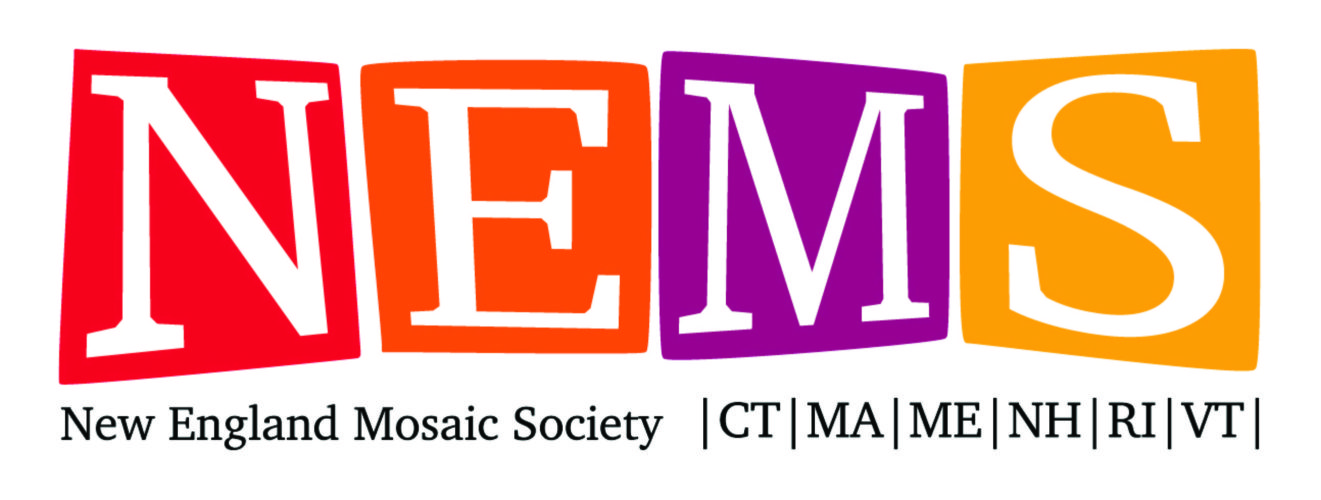One Hundred Sets of Hands
The New England Mosaic Society (NEMS) collaborated with the staff of the Charles River Museum of Industry and Innovation to design and create three large panels (42” x 68”) installed adjacent to the museum entrance on the Riverway. The designs explore the positive and negative impacts of industrialization on the Charles River and the surrounding landscape over the last four centuries. The final project was a gift from NEMS to the museum and includes the work of over 100 sets of volunteer hands: skilled mosaic artisans, craftspeople, and community members.
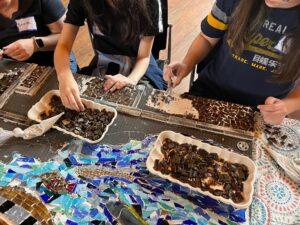
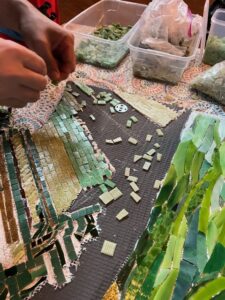
What is the Backstory? What am I seeing?
Panel#1 represents the pre-industrial period of the 1600s. The animals and plants in and around the river are native to New England, and local Native American textile patterns are incorporated into the hills. The river is pristine.
This panel represents the pre-industrial period of the 1600s. The animals and plants in and around the river are native to New England, and local Native American textile patterns are incorporated into the hills. The river is pristine.
The New England Mosaic Society created these designs in 2023 to explore the positive and negative impacts of industrialization on the Charles River and the surrounding landscape over the last four centuries. The intersection of art and technology helps to preserve history and provides an understanding of the societal and cultural trends that impact the community—people, land, the river.
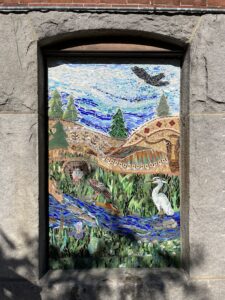
Panel #2 portrays the height of the mill operation in the 1800’s when industrialization had altered the environment, the health of the river, and the experience of workers and residents. The patterns in the hills change, and fields are woven by a mechanized loom. On the left you can see a cut-away of a mill that used the river’s water to power its machinery. There are fewer plants and animals, and the river and sky are changed by industrial waste and pollution.
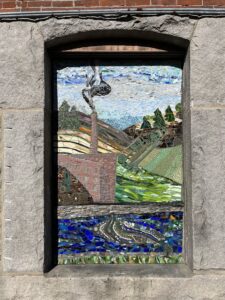
Panel #3 represents the current, post-industrial environment with both the detritus of former pollution and habitat destruction, and the authentic efforts of sanitation and environmental conservation. Ecologists lobby for environmental cleanup. There is manufacturing debris in the hills (including parts from Waltham watches!), and invasive non-native species. You’ll notice that the soil beneath the cabin is filled with sewage and freshwater delivery systems, representing the built infrastructure that continues to serve us, with the canoe representing an upsurge in river recreation. Two protest signs symbolize strong public interest and political will funneled toward environmental stewardship of the river.
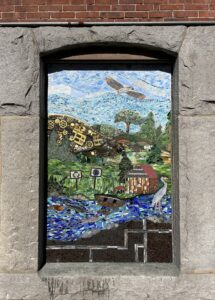
From Design to Execution
- Conception, Funding, Design: The designs reflect historical research and conversations between NEMS and Charles River Museum from 2022-2023. Designs were completed in 2023, funding was secured from the Waltham Cultural Council to purchase substrates, hardware, and other materials.
- Individual Mosaic Artists at work: Over 35 NEMS members volunteered; each individual animal, tree, rock, hill and building structure was created by a NEMS member in their own home or studio, using their own frost-proof glass, ceramic or stone materials, and delivered to the coordinator.
- Community Engagement: NEMS organized three community mosaic-making sessions during which members of the public – from small children to elders – – could help to mosaic the skies, the rivers and the fields. Weather-hardy thinset mortar was used to adhere tiles to cementitious boards. In community centers, senior facilities, and the museum, more than 100 people participated in the project!
- Weaving it all together: NEMS volunteers combined all of the individual components, facilitated the community workathons, grouted the sections, then cleaned the panels (for hours!) to make them shine.
- Finally…the Install! Panels were installed on November 2, 2023, as a gift from the New England Mosaic Society to the Charles River Museum with the help from museum volunteers. We hope that they will be enjoyed and considered by the public for years to come.
Community engagement is key.
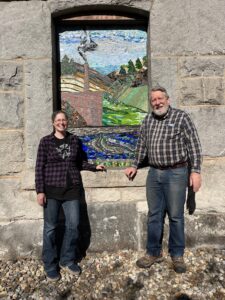 Art sometimes gets lost when there’s a strong societal emphasis on technology. Yet the intersection of art and technology helps to preserve history and provides an understanding of the societal and cultural trends that impact the community: people, land, river. We wanted this mosaic project to tell a story through art by involving the community as artists and makers.
Art sometimes gets lost when there’s a strong societal emphasis on technology. Yet the intersection of art and technology helps to preserve history and provides an understanding of the societal and cultural trends that impact the community: people, land, river. We wanted this mosaic project to tell a story through art by involving the community as artists and makers.
Through community outreach we were able to involve a diverse cross section of Waltham residents – – people of all ages from toddlers to seniors, and immigrants from many continents. Mosaic artists from every New England state contributed. Altogether we created mosaics that describe the impact of technology on the river and its surrounds, from the 1600s to today. By being involved in this project, participants were part of something larger than themselves. They now have a sense of ownership in the mosaic murals, and the mosaic-making created a sense of community in a time when many people feel isolated from each other.
THANK YOUS
This project was supported in part by the Waltham cultural council and the Massachusetts Cultural Council.
Thank you to:
- the museum staff and volunteers who helped to conceptualize the project and then make it a reality.
- the thirty-Five NEMS members who served as grant writers, project coordinators, designers, and component creators: Ellen Aiken, Susan Altman, Su Bailey, Marybeth Barker, Lee Berman, Emily Bhargava, Erika Bourne, Angel Cacciola, Cheryl Cohen, Jean Cummisky, Jennifer Dowling, Cassie Doyon, Amanda Edwards, Laurie Frazer, Amy Gilman, Cheryl Klausner, Billie Klaegraef, Cecilia Kremer, Carol Krentzman, Joanna Liss, Nancy Maloney, Lori Manfra, Rebecca Manos, Amy Marks, Suska Matsik, Pat McCristian, Erika Robbins, Betsey Rodman, Kris Samuelson, Lora Spangler, Karen Stark, Kim Stewart, Jamie Tessler, Ann Thompson, and Roberta Tobey-Gertz
- the Scandinavian center, the Waltham Community Center and the Charles River Museum for hosting community work sessions
- Emily Bhargava, for serving as project coordinator, leading and managing each step of the process
- Amy Marks, project organizer, for initiating the project, finding funding, and organizing all of the community tiling sessions
